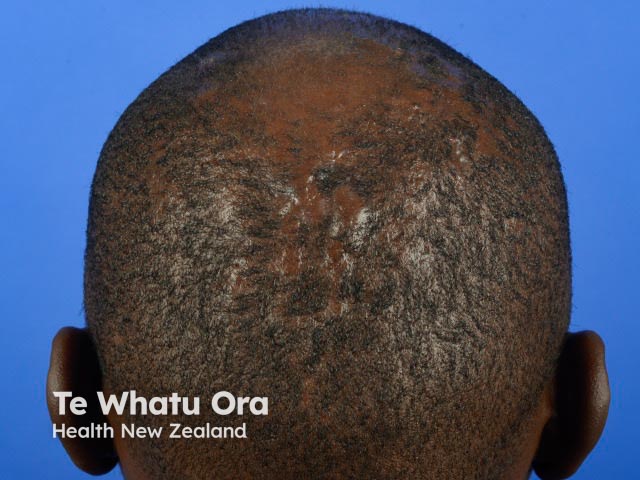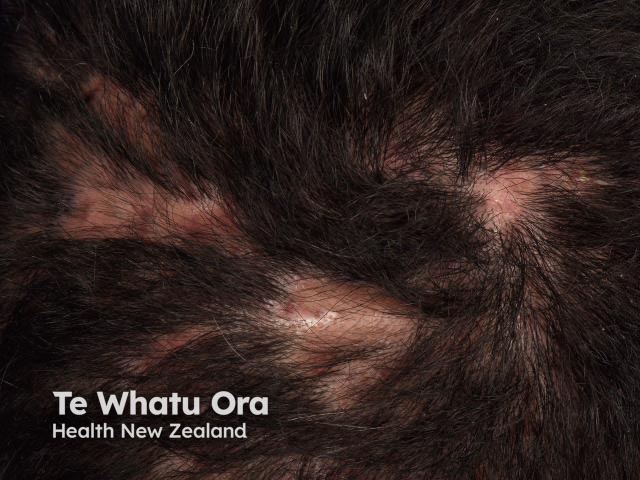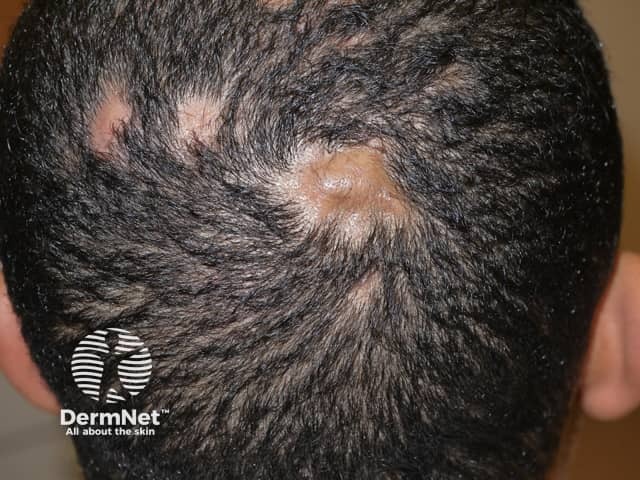Main menu
Common skin conditions

NEWS
Join DermNet PRO
Read more
Quick links
Perifolliculitis capitis abscedens et suffodiens — extra information
Perifolliculitis capitis abscedens et suffodiens
Author: Dr Leah Jones, Medical Registrar, Christchurch, New Zealand. DermNet Editor in Chief: Adjunct A/Prof Amanda Oakley, Dermatologist, Hamilton, New Zealand. Copy edited by Gus Mitchell. July 2020. Updated October 2020.
Introduction
Demographics
Causes
Clinical features
Complications
Diagnosis
Differential diagnoses
Treatment
Outcome
What is perifolliculitis capitis abscedens et suffodiens?
Perifolliculitis capitis abscedens et suffodiens is an uncommon cause of scarring alopecia characterised by perifollicular and follicular pustules and nodules.
It is also known as dissecting cellulitis of the scalp and Hoffman disease.



Who gets perifolliculitis capitis abscedens et suffodiens?
Perifolliculitis capitis abscedens et suffodiens is most commonly seen in men of African descent in the third, fourth and fifth decades of life. African women, Caucasians and other ethnicities, and occasionally children, can also present with this condition.
Perifolliculitis capitis abscedens et suffodiens sometimes occurs in people who have other forms of follicular occlusion syndrome.
What causes perifolliculitis capitis abscedens et suffodiens?
A defect in follicular keratinisation causes occlusion and subsequent inflammatory destruction of the follicle. An aberrant immune to response to commensal bacteria may be involved with the pathogenesis, particularly coagulase-negative staphylococci.
What are the clinical features of perifolliculitis capitis abscedens et suffodiens?
Perifolliculitis capitis abscedens et suffodiens can affect single or multiple areas of the scalp, with a predilection for the vertex and posterior scalp. It is typically painful.
Signs can include:
- Perifollicular and follicular pustules
- Nodules and pseudocysts, often with purulent exudate
- Interconnecting sinuses
- Abscess
- Hair loss
- Keloid scars.
Patients with perifolliculitis capitis abscedens et suffodiens may also have hidradenitis suppurativa, nodulocystic acne and/or pilonidal disease.
Perifolliculitis capitis abscedens et suffodiens is also associated with arthritis and spondyloarthropathy. Sacroiliitis is reported in three-quarters of sufferers.

Dissecting cellulitis

Dissecting cellulitis

Dissecting cellulitis
Dermoscopy features of perifolliculitis capitis abscedens et suffodiens
Three stages of disease progression have been described on dermoscopy.
- Early phase resembles alopecia areata with black dots, broken hairs, and yellow dots.
- Abscedens phase shows three-dimensional large yellow dots with a soap-bubble appearance, and yellow structureless areas.
- Fibrotic phase resembles the end stage of any cicatricial alopecia with white areas lacking follicular openings, but with a characteristic feature of cutaneous clefts with hair tufts.
What are the complications of perifolliculitis capitis abscedens et suffodiens?
Pain during acute inflammatory flares, together with the hair loss, has a major impact on quality of life.
Perifolliculitis capitis abscedens et suffodiens can be complicated by secondary bacterial infection due to Staphylococcus aureus, Pseudomonas, and anaerobic bacteria.
Hair loss is temporary initially, but the deep inflammation eventually leads to patchy cicatricial alopecia, which can be very extensive.
Cutaneous squamous cell carcinoma has been reported.
How is perifolliculitis capitis abscedens et suffodiens diagnosed?
Perifolliculitis capitis abscedens et suffodiens is a clinical diagnosis.
A swab of the exudate for culture is recommended to identify secondary bacterial infection. However the swab is often sterile.
A skin biopsy may show perifollicular mixed inflammatory infiltrate, abscess, and granuloma formation. Fibrosis is common.
What is the differential diagnosis for perifolliculitis capitis abscedens et suffodiens?
Perifolliculitis capitis abscedens et suffodiens can be confused with other inflammatory conditions of the scalp including:
- Folliculitis keloidalis nuchae — firm irritable papules on the nape of the neck
- Folliculitis decalvans — follicular pustules and scarring alopecia without nodules, sinuses, and abscesses
- Kerion — an acute abscess due to dermatophyte infection
- Bacterial folliculitis — acute or chronic follicular papules and pustules.
What is the treatment for perifolliculitis capitis abscedens et suffodiens?
Treatment of perifolliculitis capitis abscedens et suffodiens often requires a multi-pronged approach, especially initially and during acute flares.
Medical treatment
- Oral antibiotics, such as tetracyclines or erythromycin for their anti-inflammatory and antibacterial action
- Oral isotretinoin
- Oral corticosteroids
- Intralesional corticosteroid injection
- Analgesia
- Topical antiseptic cleansers
- Oral zinc
- Biological agents such as antitumour necrosis factor-alpha (TNF) inhibitors, such as adalimumab.
Surgical treatment
- Incision and drainage of abscesses
- Surgical excision
- Surgical resection and skin grafting
- Laser epilation
- Carbon dioxide laser ablation
- Radiotherapy
- Photodynamic therapy.
What is the outcome for perifolliculitis capitis abscedens et suffodiens?
Perifolliculitis capitis abscedens et suffodiens usually follows a chronic course with variable relapses. The subsequent scarring alopecia results in permanent, patchy hair loss.
References
- Cuellar TA, Roh DS, Sampson CE. Dissecting cellulitis of the scalp: a review and case studies of surgical reconstruction. Plast Reconstr Surg Glob Open. 2020;8(8):e3015. doi:10.1097/GOX.0000000000003015. PubMed
- Curry SS, Gaither DH, King LE Jr. Squamous cell carcinoma arising in dissecting perifolliculitis of the scalp. A case report and review of secondary squamous cell carcinomas. J Am Acad Dermatol. 1981;4(6):673–8. doi:10.1016/s0190-9622(81)70068-9. PubMed
- Farrant P, Mowbrat M, Sinclair RD. Dermatoses of the scalp. In: Griffiths C, Barker J, Bleiker T, Chalmers R, Creamer D (eds). Rook's Textbook of Dermatology [4 volumes], 9th edn, Wiley Blackwell, 2016: 107.8-9.
- Melo DF, Lemes LR, Pirmez R, Duque-Estrada B. Trichoscopic stages of dissecting cellulitis: a potential complementary tool to clinical assessment. An Bras Dermatol. 2020;95(4):514–17. doi:10.1016/j.abd.2019.10.008. PubMed
- Scheinfeld N. Dissecting cellulitis (perifolliculitis capitis abscedens et suffodiens): a comprehensive review focusing on new treatments and findings of the last decade with commentary comparing the therapies and causes of dissecting cellulitis to hidradenitis suppurativa. Dermatol Online J. 2014;20(5):22692. PubMed
- Takahashi T, Yamasaki K, Terui H, et al. Perifolliculitis capitis abscedens et suffodiens treatment with tumor necrosis factor inhibitors: a case report and review of published cases. J Dermatol. 2019;46(9):802–7. doi:10.1111/1346-8138.14998. PubMed
- Thein M, Hogarth MB, Acland K. Seronegative arthritis associated with the follicular occlusion triad. Clin Exp Dermatol. 2004;29(5):550–2. doi:10.1111/j.1365-2230.2004.01582.x. PubMed
On DermNet
- Scalp folliculitis
- Scalp folliculitis images
- Dissecting cellulitis of the scalp case 1
- Hidradenitis suppurativa
- Nodulocystic acne
- Pilonidal disease
- Follicular occlusion syndrome
- Diagnosis of scalp rashes
Other websites
- Perifolliculitis Capitis Abscedens Et Suffodiens — Medscape Reference
- Dissecting cellulitis of the scalp — British Association of Dermatologists
